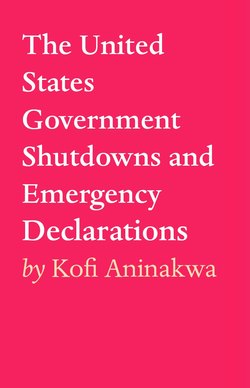Читать книгу The United States Government Shutdowns and Emergency Declarations - Kofi Aninakwa - Страница 3
На сайте Литреса книга снята с продажи.
Preface
ОглавлениеA government shutdown occurs when Congress does not approve of or the president rejects federal budget for the upcoming fiscal year or continuous resolution for short term thereof and nonessential functions of the U.S. government close until lawmakers can agree on a budget. Some government functions such as the Federal Reserve System are completely self-funded. Others, like Social Security and Medicare, are partially self-funded but may be subject to administrative shutdowns. Some programs are fully or partially funded for multiple years and some are funded annually. They may fail if the government does not meet its financial obligations.
Since the 1990s, Congress has often failed to pass the twelve to thirteen appropriation bills that set government-wide spending. In their stead they pass "continuing resolutions (CR)" to extend the existing spending law at or near current levels, and "omnibus" bills that combine many appropriations bills into one. Budget negotiations can be difficult when the president is not of the party that controls one or both houses of Congress. The last budget was passed on April 29, 2009.
A continuing resolution temporarily funds the government in the absence of full appropriations bills, often by continuing funding levels from the prior year. Traditionally, the CRs have been used to give lawmakers a short period of time to complete their work on the remaining appropriations bills while keeping the government operating. CRs sometimes apply to only a few categories of spending, but they can also be used to fund all discretionary functions and can be used for an entire year.
